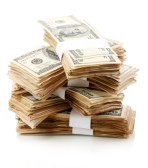“King Dollar” Is Back – Or Is It?
Thursday, October 2nd, 2014 @ 4:27PM
Gary D. Halbert
Between the Lines
The US Dollar has surged higher since the middle of this year. Yet most Americans pay little attention to the fluctuations in our currency, even though most of us get paid exclusively in dollars and spend exclusively in dollars. Since most of us don’t travel outside the country frequently and have to convert our dollars into foreign currencies – which may be higher or lower – we don’t tend to care if the US dollar is rising or falling, except in extreme cases.
The US Dollar Index, which measures the value of the greenback against a basket of foreign currencies, has climbed to its highest level in over four years. Analysts at Société Générale noted that: “The momentum of the dollar’s advance is unprecedented,” in a memo released on Tuesday.
The US dollar has been the world’s “reserve currency” since 1921. As such, the greenback is held in significant quantities by governments and institutions around the world as part of their foreign exchange reserves, and is commonly used in international transactions. The US dollar has long been the world’s top business currency.
The recent run-up is partly because traders believe the American economy is improving, especially relative to other parts of the world. If the economy continues to improve, that will compel the Federal Reserve to raise interest rates, which is generally seen as a good thing for a country’s currency. This is another factor supporting a stronger dollar. The Fed is expected to start raising short-term interest rates around the middle of next year.
At the same time, things are looking bad in Europe, so the European Central Bank is starting to do more stimulating (QE) of its own. Those measures have resulted in a weaker euro. The Japanese yen has plunged the last two years because of the country’s ongoing economic problems. These developments have also helped strengthen the US dollar.
Most forecasters believe the dollar uptrend is likely to continue. Analysts with Capital Economics say they expect the dollar “to appreciate further as the monetary policy of the Fed diverges from that of central banks elsewhere.”
They predict that the euro will be worth only $1.15 by the end of next year, compared with around $1.27 now. The US dollar has already gained more than 8% against the euro in the past six months. Here’s what the longer-term US dollar chart looks like:
While the dollar has been on a rampage over the last several months, it still looks relatively cheap compared to the lofty levels seen during 2000-2003. The latest surge has been driven by a lot of “short-covering,” but it remains to be seen if the rally will continue.
Let’s assume it does. So what does a stronger dollar mean for the average American?
1. Americans can take comfort in the fact that a strong dollar is a sign of global confidence in the US economy. It means foreign investors believe that the US is a good place to park some money for the foreseeable future.
2. A strong currency also makes it cheaper for companies to import goods from abroad. In other words, consumers stand to benefit from lower prices. A strong dollar also acts to keep inflation in check, which in turn should limit interest rate increases by the Fed.
3. And if you’re planning a vacation abroad, you might want to do some shopping, since a favorable exchange rate should give you a little more bang for your buck.
4. While a robust dollar cheapens imports, it makes American exports more expensive to the rest of the world. That can hurt domestic manufacturing as US firms end-up competing for consumers with international rivals that can offer discounted products.
Furthermore, American-based multinationals that sell a large amount of their goods overseas are at a disadvantage when they have to exchange revenues earned abroad back into dollars – not to mention the onerous new rules the Treasury has imposed to crack down on tax inversions (see my latest E-Letter for more details).
Conclusions. While the pros and cons of a stronger dollar are very real, it’s probably too early to tell the extent to which it will affect consumers and businesses. As illustrated in the chart just above, the US dollar is still relatively cheap and it remains to be seen if it will surpass the highs seen in 2008-2010.
Most forecasters seem to believe the dollar will continue to rise, and if the economy continues to improve, I would agree. Yet despite the nice bump in GDP in the 2Q (+4.6%), most agree that the economy will expand by only 2.5-3.0% going forward. Given that, I wouldn’t make any big bets on the US dollar just yet.
Posted by AIA Research & Editorial Staff
Categories: Between the Lines




